
How To Process Your Salvia Divinorum Plant
If you want to have properly dried leaves of a Salvia divinorum plant, check out this article to see how to process them correctly for ingestion. See which techniques are most efficient and which ones optimise potency.
So, you have grown your own Salvia divinorum plant. Everything went according to plan, you've taken good care of your darling and in the end, she grew into a beautiful lady. But what to do now? The plant looks awesome and you desire its precious leaves because that's what all the fuss is about. How do you make those leaves into something you can consume to induce a proper effect?
We tell you exactly how in this article. There are a few different methods of processing a Salvia divinorum plant and we got you covered here. Come on, let’s find out how to work those legendary leaves!
THE VARIOUS METHODS OF DRYING SALVIA DIVINORUM LEAVES
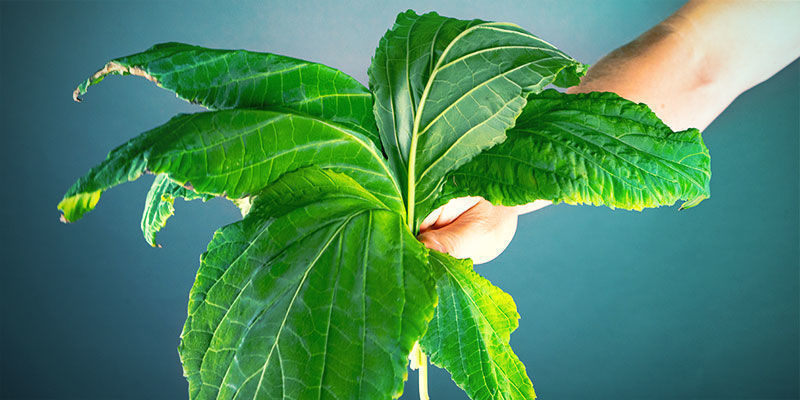
You have grown your own Salvia divinorum plant and now you want to dry its leaves for future use. Before we start, it is worth mentioning that regardless of the method you use to process, you want to make sure that leaves are stored properly in sealed containers afterwards. You should also keep them away from light, in a dark place like a kitchen cabinet or a medicine chest. If you store them this way in a glass jar, they will retain their potency for many, many years to come, maybe even indefinitely. Who knows?
NATURE'S BOUNTY
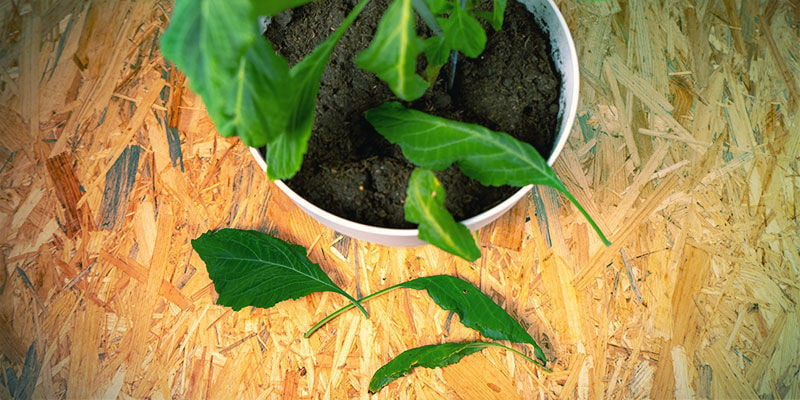
Wait to collect your leaves until they die or are shed by the plant. Now, you should place them in a room with low humidity to dry. To avoid moulding, you must turn the leaves around many times. Apart from that, you just have to wait for them to dry and then you can store them as described above. Note: it is not presently known if the naturally shed leaves are stronger than the picked ones. Here, there is room for experimentation. Separate the shed and picked leaves, process them separately, and store them in different jars. Then, test for yourself to see which ones are more potent. Maybe there isn't even a difference at all.
The advantage of this method is that you don't stress your Salvia divinorum plant by depriving it of all its leaves. Imagine picking off all of them - your plant will slowly die. You have to wait for the leaves to fall off when the plant gives you her sacrifice. When picked, the leaves are also not in the best condition to be processed.
SALVIA TOBACCO
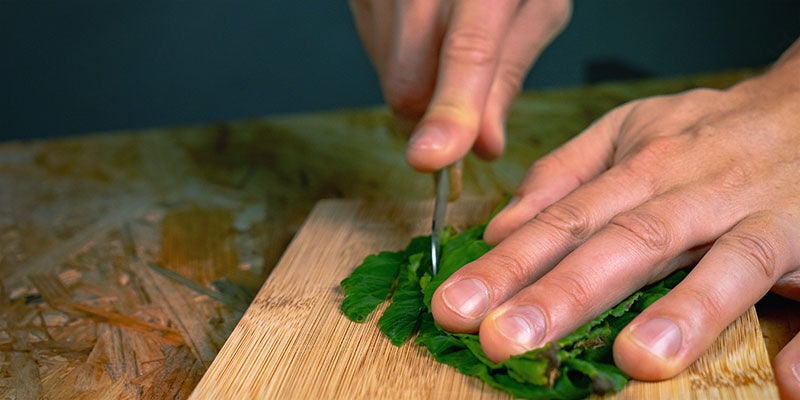
This method is the other way around. You use big, freshly picked leaves and stack them atop of one another like you would sheets of paper. Then, cut through the stacked leaves to make ½cm strips out of the pile. Now, form them into a heap on a plate. The waiting process begins. You have to turn them twice daily to prevent mould. Let them process until they feel dry, just not bone-dry.
The downside of this way of processing is that the slow and partially-dried leaves are possibly weaker than thoroughly dried ones. You have to decide for yourself if you’ll trade smoothness for potency.
FOOD DEHYDRATOR
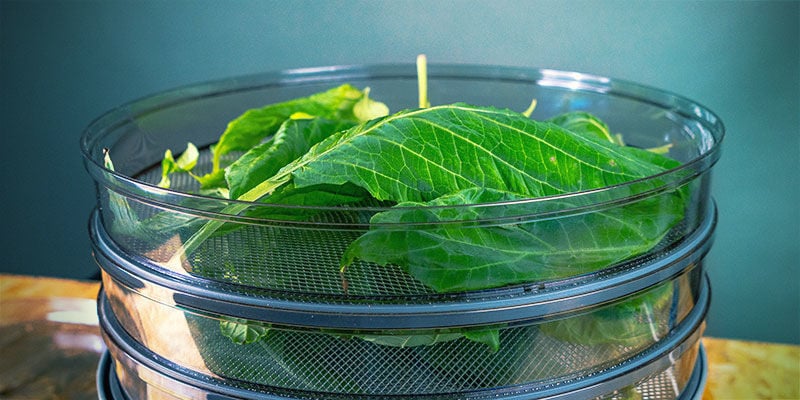
Simply dry your leaves in a food dehydrator. You can purchase them in any store where small kitchen devices are sold. This way of drying is very fast and thorough, so you save time and can consume your salvia earlier. You should dry the leaves until they are really crispy. This also includes the stems. The stems are a great way of knowing the best drying state because you can bend them and see if they snap. If they do, then you will know that the leaves are ready.
Using a food dehydrator saves you a lot of time because it is a quick way of drying. Moreover, you will probably not get them any drier than with this kitchen device. It's also pretty convenient since you don't have to do much compared to other methods, just check the drying state of the leaves. Still, there is greater cost to buying a food dehydrator if you don't own one already. But it can be a rewarding investment!
OVEN DRY YOUR SALVIA
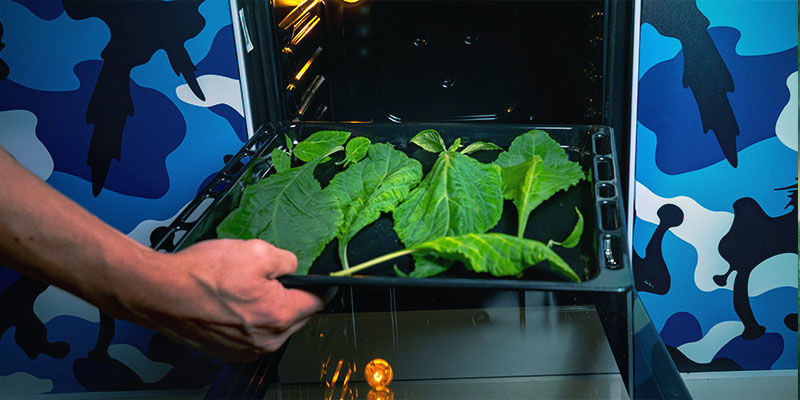
Place your leaves in an oven-proof dish. Be careful to dry your salvia at a temperature of only 93°C. Dry till the leaves are crispy. This is also a fast and thorough way of processing and is more convenient and cost-effective than a food dehydrator. Everyone has an oven in the kitchen, right? Nevertheless, it can be tough to keep the oven temperature at the optimal range. Unless you have an oven with a digital temperature display, dialling in the perfect temperature for this process can be quite tricky.
CALCIUM CHLORIDE (CACL₂) DRYING
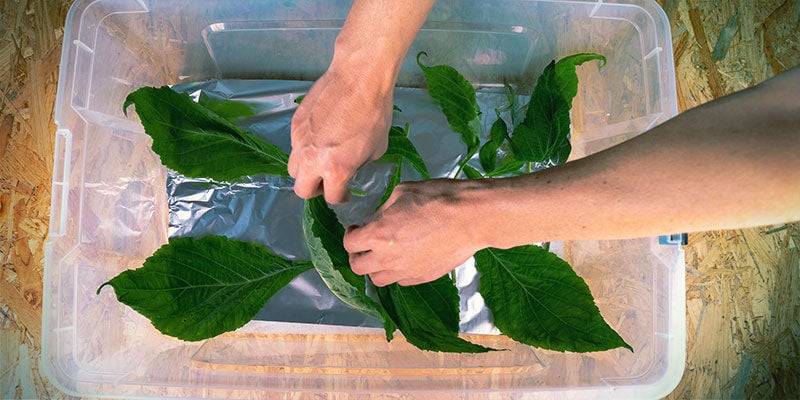
You might think now: "Wait, what? calcium chloride?" But it's actually not as complicated as you might expect it to be. Calcium chloride is available in chemical supply houses. Some hardware stores sell it as a moisture absorber too. And that's exactly the purpose it serves in this drying method. Place enough calcium chloride to cover the bottom of a polyethylene container and put a piece of aluminum foil on top of it. At last, place the leaves to be dried on the foil. When you curl up the edges of the aluminum foil, the leaves should not touch the CaCl₂. And make sure they don't! Now, seal the container - after two days the leaves should be dry.
The CaCl₂ makes for a very vigorous drying procedure. Nonetheless, you will be scared off by the name of this technique alone. It's not as convenient as the other processing methods we have looked at. Compared to some procedures, two days of drying is quite slow. But if the scientist and chemist inside you has awakened, this technique can be a nerd's dream come true.
MAKING A SALVIA EXTRACT
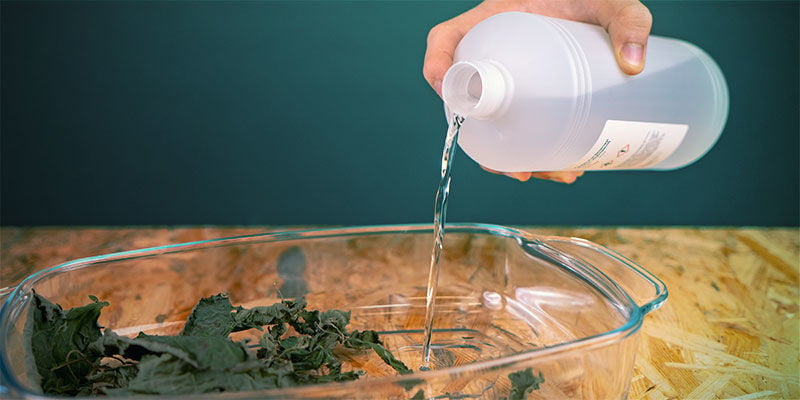
Last but not least, we provide you with information on how to make your own extract of Salvia divinorum. The above mentioned methods all concern ingesting the leaves. This generally induces a mild effect. Plus, making the leaves into a brew or chewing them does taste awful and you would have to intake decent amounts of it. But, when the leaves are made into an essence, the effect will be much more potent and the dosing will be very easy.
We have a helpful article which discusses this process in detail; here we give you the extraction method in a nutshell. With this method, you also have to dry the leaves. Luckily, this is done using the oven technique, so you got that already covered. Place the dried leaves in a mason jar and cover them with acetone. Please, be careful at this point since acetone is highly flammable; its vapors are toxic and it dissolves plastic!
The solution should sit for 24 hours; stir it once in awhile. Then, pour it through a coffee filter, set the acetone solution aside, and soak the leaves once again with acetone. You can repeat this process several times. Pour the acetone solution in a glass baking dish and let it evaporate. Put the crushed salvia leaves in there and let the mix evaporate and dry out. When it is dry, let it sit for one or two more days and be sure that all the acetone is gone. And voilà - there you have it! A homemade, high-quality and super potent Salvia divinorum extract!
DISCOVER SALVIA DIVINORUM NOW
So there you have it, the various methods you can utilise to dry, process and create extracts from your own Salvia divinorum plant. Whichever way you're looking to use your “sage of the diviners”, it should be noted that it has some pretty potent psychoactive effects. With that in mind, it may be best to start off with lower doses to get an initial feel for it before increasing the amount.
Fortunately, it's never been simpler to grow Salvia from home. Head over to the Zamnesia store, where you can find the finest cuttings to cultivate. We also stock dried leaves and extracts with varying potency levels to cater to all needs.
-
 4 min
22 November 2020
Salvia Divinorum: The Do's And Don'ts
Whether you're a seasoned expert or total novice, keep reading as we break down the most important things to consider before any salvia trip.
4 min
22 November 2020
Salvia Divinorum: The Do's And Don'ts
Whether you're a seasoned expert or total novice, keep reading as we break down the most important things to consider before any salvia trip.
-
 5 min
3 October 2019
The Psychedelic Trip Sitter's Guide
Whether you are new to psychedelics or an experienced hand, the benefits of a trip sitter are significant. While they will not guide your trip, they are there to make sure you can explore the...
5 min
3 October 2019
The Psychedelic Trip Sitter's Guide
Whether you are new to psychedelics or an experienced hand, the benefits of a trip sitter are significant. While they will not guide your trip, they are there to make sure you can explore the...
-
 4 min
5 February 2019
9 (Legal) Drugs That Will Induce a Psychedelic Trip
While most psychedelic substances are considered illegal in many countries, there are a few that buck the trend. From plants of the rain forest used for powerful psychedelic brews, to the mystical...
4 min
5 February 2019
9 (Legal) Drugs That Will Induce a Psychedelic Trip
While most psychedelic substances are considered illegal in many countries, there are a few that buck the trend. From plants of the rain forest used for powerful psychedelic brews, to the mystical...
-
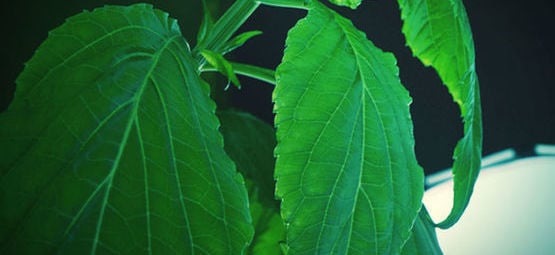 15 min
21 January 2019
Salvia: Everything You Need To Know
15 min
21 January 2019
Salvia: Everything You Need To Know













 United States
United States










